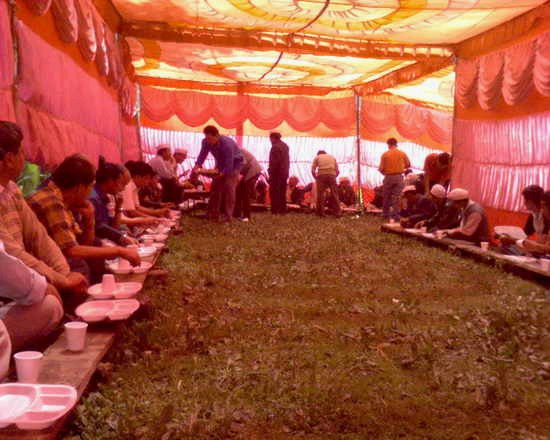Traditionally, the Shaukas lived a nomadic life, travelling with their large flocks of pack goats, sheep and ponies from the trade posts of Gangtok and Gyanima in Tibet, across the innumerable ridges and valleys of Kumaon into the Gangetic plains. The annual migrations of their caravans took place along established trade routes, for the Shaukas were legendary traders and trans-Himalayan trade partnerships with nomadic Tibetan Khampas and Dokpas were formed and nurtured over generations, until China invaded Tibet and the subsequent Sino-Indian War in 1962 caused trade to be stopped completely.
This caused great upheaval in the lives of the Shaukas. Nomadic trade was in their blood, and they maintained vast flocks of pack animals for the sole purpose of transporting costly goods over the hundreds of difficult miles which separate Tibet from the cities in the plains of India. At Gangtok, in late August, the Shauka caravans would be loaded with valuable Tibetan wool, gold dust, borax and rock salt and begin the descent over the passes into India in early September. After celebrating the mid-September festival of Nandashtami (in honour of the goddess 'Nanda Devi' whose abode is on the 25,645 feet high peak of the same name in the Johar valley) in their villages, the traders travelled down the mountains to the plains as far as Varanasi to purchase silks, spices and jaggery. In mid March the caravans ascended the mountains and crossed once again into Tibet by June. During this time, the women would remain their villages, surrounded by high peaks and alpine pastures rich in medicinal herbs and covered with sweet grass and beautiful flowers. The journey from Johar to Tibet was the most hazardous and bad weather on the frozen heights of the windswept passes caused many men and animals to perish.
At times, Shauka women accompanied the caravans to Tibet, in order to undertake the holiest of Hindu pilgrimages, to the scared Mount Kailash, abode of Lord Shiva, and to Manasarovar, the lake of supreme consciousness. It was by observing and befriend ingnomadic Khampa women there, who wove beautiful carpets, shawls, fabric, saddle rugs and blankets, that the Shauka women brought back with them the art of weaving, and caused it to flourish as a vibrant and profitable cottage industry. The entire process of dyeing, carding, spinning and weaving wool was done exclusively by women on homemade spindles and looms, using vegetable dyes. Original Tibetan patterns and motifs were refined and altered to create a typical style of Shauka weaving. It was not surprising, therefore, that these highland communities were prosperous and cultured. Although they have always worshipped the Hindu deities Shiva and Shakti, who are believed to dwell on the Himalayan peaks Mt. Kailash and Nanda Devi, many cultural and religious aspects of Shauka society were influenced by Tibetan Buddhism. The Shauka had formed strong social and cultural bonds with the Tibetans which passed from one generation to another.
When trade, the vital link between the two countries, was cut off all of a sudden, the Shaukas faced a very uncertain future. Their huge flocks, once a primary asset, were rendered useless as there were no more goods to transport. Moreover, the forests of Kumaon, once abundant and rich in grazing, had been steadily depleted not so much by the local population as by large scale commercial exploitation. As wool ceased to be supplied from Tibet, the cottage industry of weaving also came to a virtual standstill, and the Shauka community struggled to survive and to find a place in the new order of life.
Thursday, May 15, 2008
Subscribe to:
Post Comments (Atom)



No comments:
Post a Comment